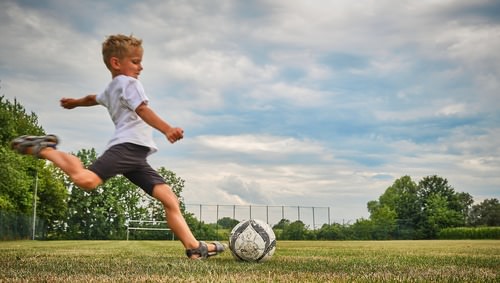怀孕与儿童
Section outline
-
Does a baby learn much during his first year?
::婴儿在一年级学到很多东西吗?The first years of life are full of important milestones as new skills are mastered. For example, at first this baby wasn't even able to roll over on their stomach or hold up their head!
::生命的最初几年随着新技能的掌握而充满了重要的里程碑。例如,最初,这个婴儿甚至不能在他们的肚子上翻滚或抬起他们的头!Infancy and Childhood
::怀孕与儿童The first year after birth is called . Infancy is a period when the baby grows very fast. During infancy, the baby doubles in length and triples in weight. Other important changes also happen during infancy:
::婴儿出生后第一年被称为婴儿出生后第一年。孕期是婴儿生长速度非常快的时期。婴儿在婴儿期,婴儿的长度增加了一倍,体重增加了三倍。在婴儿期,其他的重要变化也发生在婴儿期:-
The baby's teeth start to come in, usually at about six months of age (
Figure
).
::婴儿的牙齿开始长出,通常在大约6个月大的时候(图)。 -
The baby starts smiling, paying attention to other people, and grabbing toys.
::婴儿开始微笑, 关注他人, 抢取玩具。 -
The baby begins making babbling sounds. By the end of the first year, the baby is starting to say a few words, such as “mama” and “dada.”
::婴儿开始胡言乱语。 到一年级结束时,婴儿开始说几句话,比如“妈妈”和“达达 ” 。 -
The baby learns to sit, crawl, and stand. By the end of the first year, the baby may be starting to walk.
::婴儿学会坐着、爬行和站立,到一年级结束时,婴儿可能开始走路。
This baby's teeth have started to come in. Babies often chew on toys or other objects when they are getting new teeth. They may even chew on their toes. Childhood begins after the baby’s first birthday and continues until the teen years. Between one and three years of age, a child is called a toddler . During the toddler stage, growth is still fast, but not as fast as it was during infancy. A toddler learns many new words. The child even starts putting together words in simple sentences. Motor skills also develop quickly during this stage. By age three, most children can run and climb steps. They can hold crayons and scribble with them. They can also feed themselves and use the toilet.
::童年从婴儿一岁开始,一直持续到十岁。一到三岁的儿童被称为幼儿。在幼儿阶段,成长速度仍然很快,但不像婴儿阶段那样快。幼儿学习了许多新词。儿童甚至开始用简单的句子拼写词句。运动技能在这个阶段也迅速发展。到了三岁,大多数儿童可以跑步爬步。他们可以拿着蜡笔,用笔写字。他们也可以自己喂饱自己,用厕所。From age three until the teens, growth is slower. The body also changes shape. The arms and legs get longer compared to the trunk. Children continue to develop new motor skills. For example, many young children learn how to ride a tricycle and then a bicycle. Most also learn how to play games and sports ( Figure ). By age six, children start losing their baby teeth. Their permanent teeth begin coming in to replace them. They also start school and learn how to read and write. They develop friendships and become less dependent on their parents.
::从三岁到十几岁,成长速度较慢。身体也变形。胳膊和腿与树干相比变长。儿童继续发展新的运动技能。例如,许多幼儿学习骑三轮车,然后骑自行车。大多数幼儿还学会如何玩游戏和运动(图 )。六岁时,儿童开始失去婴儿牙齿。他们的长牙开始来取而代之。他们也开始上学,学会读写。他们发展友谊,不再依赖父母。Children develop better motor skills as they get older. Early Childhood Development
::幼儿发展There are numerous milestones that occur during the first few years of childhood. These include
::在童年的头几年里,出现了许多里程碑。-
the use of
language
,
::使用语言, -
walking and running,
::奔走的、奔驰的、 -
understanding simple concepts,
::理解简单的概念, -
pretend play,
::假装玩耍, -
the
of fine motor skills,
::具备良好的运动技能, -
the development of independence,
::发展独立, -
having temper tantrums,
::脾气暴躁, -
demonstrating separation anxiety,
::表明分离焦虑, -
becoming fully potty-trained,
::获得完全的陶器训练, -
showing natural curiosity.
::显示自然好奇。
Science Friday : The Real Guide to Imaginary Companions
::科学星期五:想象伴侣的真实指南Children often have imaginary friends of various shapes and sizes. In this two-part video series by Science Friday , psychologists Marjorie Taylor and Tracy Gleason discuss why kids create these companions, and the roles that these companions play in development.
::孩子们常常有不同形状和大小的想象朋友。 在这由ScienceFriday、心理学家Marjorie Taylor和Tracy Gleason组成的两部分视频系列中,儿童们讨论了为什么孩子创造这些伴侣,以及这些伴侣在发展过程中扮演的角色。Science Friday : Babies on the Brink
::科学星期五:布林克岛的婴儿Developmental psychologists believe that infants learn to fear heights as they learn to crawl. In this video by Science Friday , Karen Adolph of NYU's Infant Action Lab has reveals that while babies can learn from experiences near high ledges or narrow bridges, it's not a phobia they acquire.
::发展心理学家相信婴儿在学会爬行时会学会惧怕高度。 纽约大学婴儿行动实验室的Karen Adolph在ScienceFriday的这段影片中透露,虽然婴儿可以从高架或窄桥附近的经历中学习,但这不是他们获得的恐惧症。Summary
::摘要-
The first year after birth is called infancy, after which childhood begins.
::出生后第一年被称为婴儿,从婴儿出生后开始。 -
An individual grows quickly and develops new abilities during infancy and childhood.
::一个人迅速成长,在婴儿和儿童时期发展新的能力。
Explore More
::探索更多Use the resource below to answer the questions that follow.
::利用以下资源回答以下问题。-
Infancy Studies Laboratory
at
(2:07)
:2:07) 时空研究实验室
-
At what age do the researchers like to see infants to study cognitive development?
::研究人员在什么年龄喜欢看婴儿研究认知发展? -
Why is it important to establish a baseline in research of this nature?
::为什么必须在这种性质的研究中建立基线? -
How do researchers hope to use information they are collecting to help children with language problems?
::研究人员希望如何利用他们收集的信息帮助有语言问题的儿童?
Review
::回顾-
What is infancy?
::什么是婴儿? -
What changes in size happen during infancy?
::婴儿时期的体积变化如何? -
What is a toddler?
::什么是学龄前儿童? -
List three milestones of early childhood.
::列出幼儿期的三个里程碑。
-
The baby's teeth start to come in, usually at about six months of age (
Figure
).


